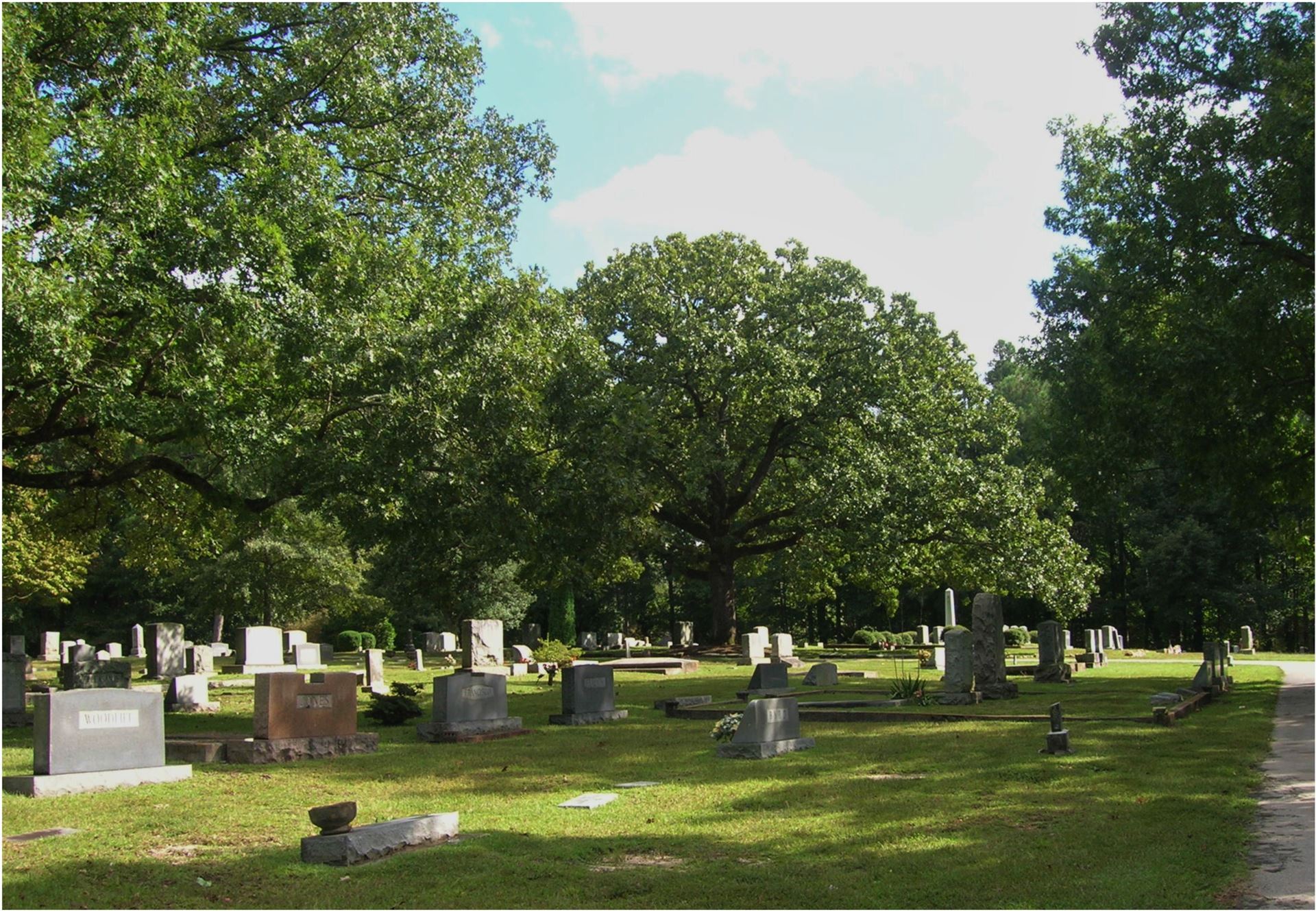
Author's note: Excerpts of this blog were taken from a comprehensive document put together by Friends of the Page-Walker, Marla Dorrel and Pat Fish in 2009. Read Mysteries and Secrets: Exploring Hillcrest Cemetery.
Join us, with a spirit willing to be haunted by the stories and the images, the mysteries and the secrets, we’ve found in Hillcrest Cemetery. If you were to close your eyes and imagine the perfect, idyllic small-town cemetery, you might very well conjure up Hillcrest. True to its name, Hillcrest Cemetery is at the top of a hill. It’s surrounded by homes and appears to serve the adjacent neighborhoods as a passive park. It’s not unusual to see people walking their dogs through the cemetery (notwithstanding a town ordinance against this) or children riding their bikes along the peaceful, paved paths. Hillcrest is located just a few blocks from Cary’s downtown historic district, easily within walking distance. Nevertheless, it remains one of Cary’s hidden secrets.
Let’s start, then, by sharing a secret. Finding Hillcrest.
Finding Hillcrest is easy, if you start from one of Cary’s most notable landmarks: Old Cary Elementary (now the Cary Arts Center).Go west on Dry Avenue, crossing South Harrison, to Page Street.Turn left and the rest is really simple – Page Street ends at the cemetery gate. The cemetery opens daily at 8:00 am and closes during the winter months at 6:00 pm; during the summer, it’s open until 8:00 pm.
Hillcrest is owned by the Town of Cary, but that was not always the case. According to the Town’s records, the Hillcrest Cemetery property was first owned by R. O. Heater, who conveyed the first tracts, commonly known as the “old section,” to the Hillcrest Cemetery Association on June 11, 1945. Ten years later, GeorgeTurner conveyed additional tracts to the Association. These tracts were conveyed to the Town of Cary in 1970; in1977, more tracts were deeded over to the Town.
The map from the Town of Cary shows an aerial view of Hillcrest, with many of the grave sites identified. Wake County land records show the cemetery property to cover 4.9acres.
Earliest dates on gravestones
 We wondered which graves were the earliest and, based on the cemetery census, here’s what we found. The earliest recorded date of birth is that of Henry Jones, born on January 29, 1766. He was the son of Nathaniel Jones of Crabtree and the husband of Nancy Jones, daughter of Nathaniel Jones of White Plains. The house Henry and Nancy lived in, built in 1803, is still standing on Chapel Hill Rd. and is a Cary Historic Landmark. Learn about the Nancy Jones House.
We wondered which graves were the earliest and, based on the cemetery census, here’s what we found. The earliest recorded date of birth is that of Henry Jones, born on January 29, 1766. He was the son of Nathaniel Jones of Crabtree and the husband of Nancy Jones, daughter of Nathaniel Jones of White Plains. The house Henry and Nancy lived in, built in 1803, is still standing on Chapel Hill Rd. and is a Cary Historic Landmark. Learn about the Nancy Jones House.
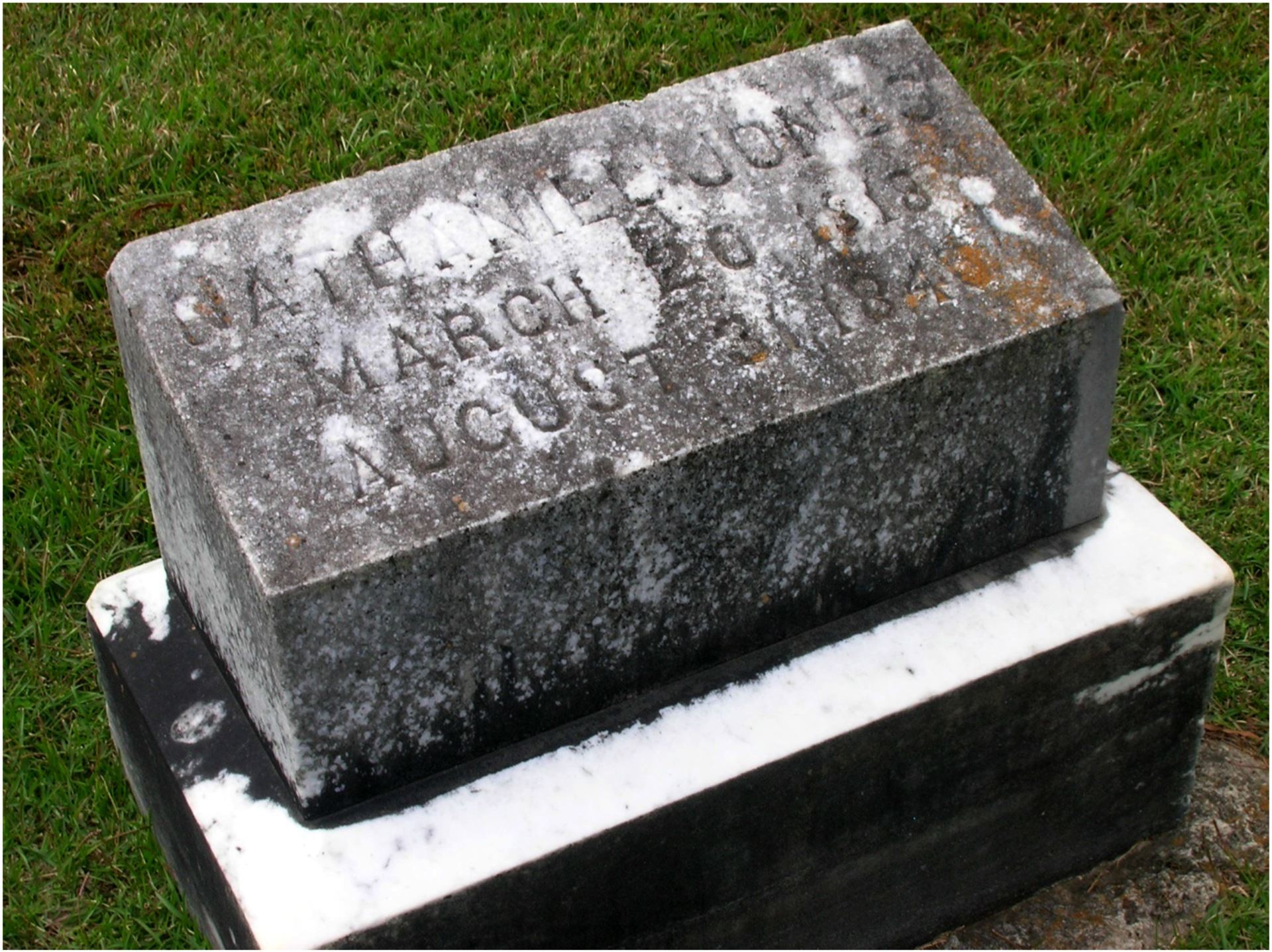
The earliest recorded date of death is also among the Joneses – Nathaniel Jones, who died on August 31, 1840 – just 40 days before the death of Henry Jones. This Nathaniel Jones, however, is not Nathaniel Jones of Crabtree or Nathaniel Jones of White Plains. Nathaniel Jones was a popular name back then!
MYSTERY: Who is buried in the ten graves whose headstones are unreadable?
 A cemetery census conducted by Shirley Olson in 2005, and updated by Karen Freeman in 2008, identified ten unreadable or unmarked headstones in Hillcrest. We may never know what secrets lie buried in these places.
A cemetery census conducted by Shirley Olson in 2005, and updated by Karen Freeman in 2008, identified ten unreadable or unmarked headstones in Hillcrest. We may never know what secrets lie buried in these places.
Markers and Headstones
Hillcrest presents an interesting assortment of grave markers, both old and new. Here are just a few of the interesting shapes we found.

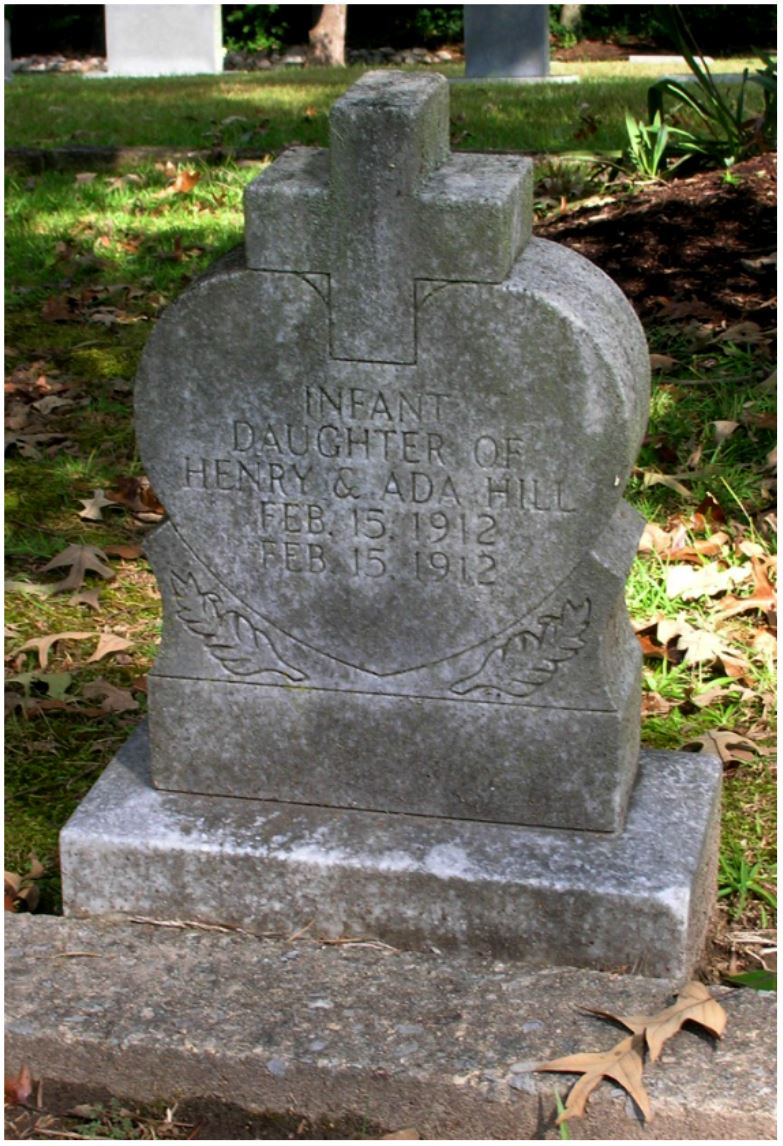

While most of the graves have the traditional monument headstone, there are a number of examples of more distinctive markers. The box tomb; the headstone and footstone - in this case with a ledger marker (the moss-covered,concrete pad) and the obelisk.
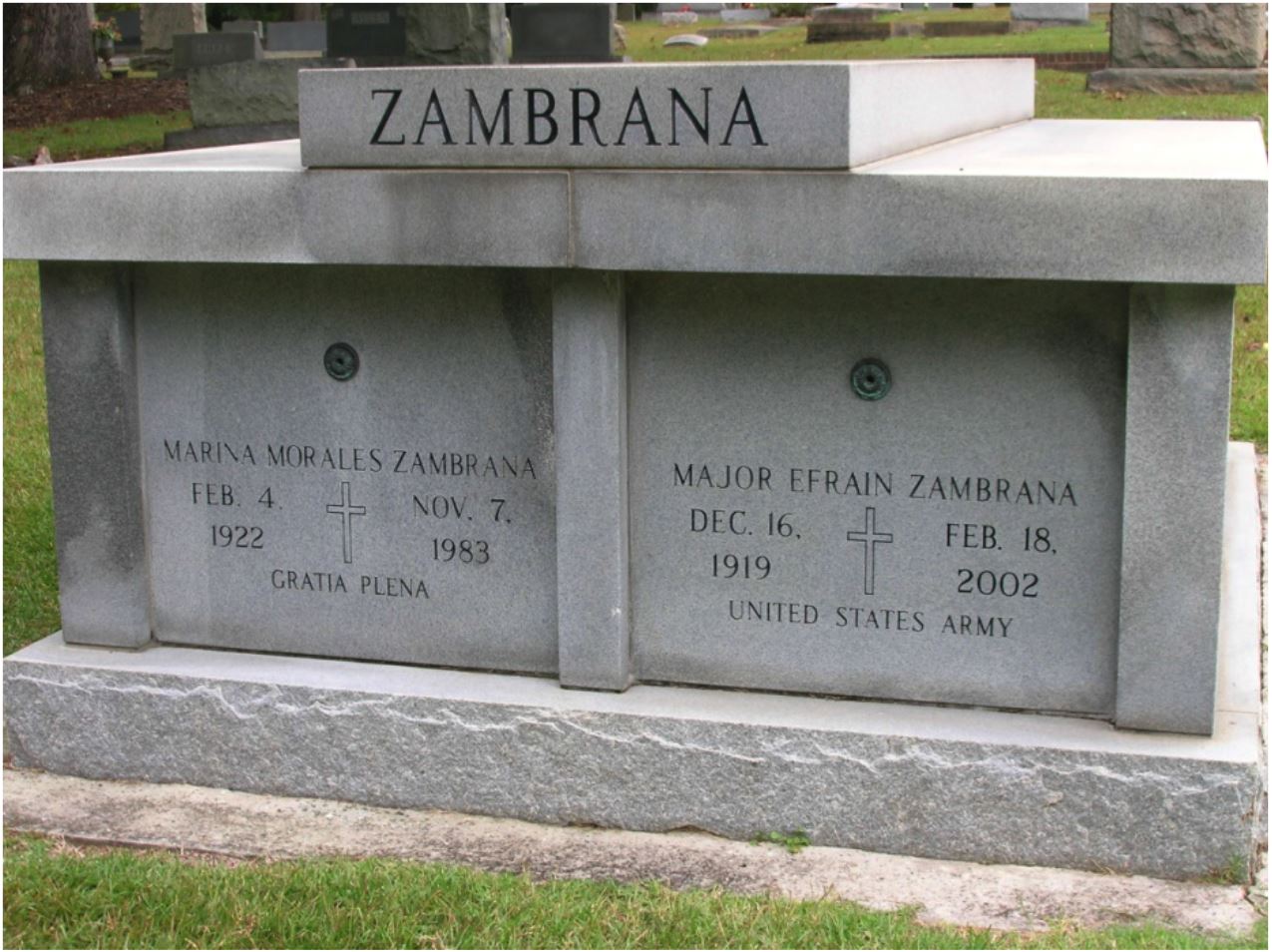
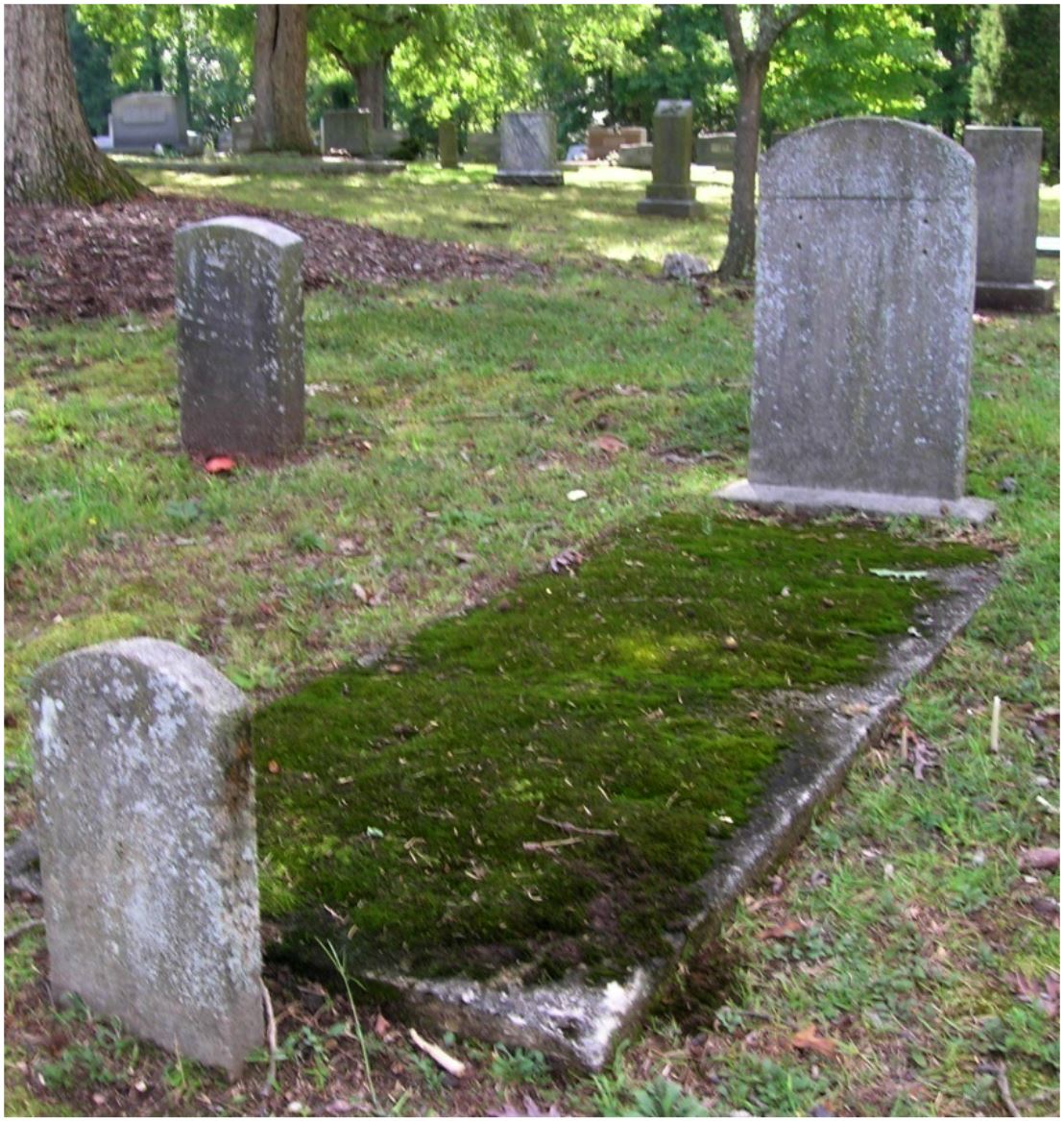

Hillcrest also displays a wide array of artistic designs, some of which give us clues about those who are buried there. The book, “Stories In Stone, A Field Guide to Cemetery Symbolism and Iconography,” opens its chapter on Flora by reminding us, “Flowers have served as symbols of remembrance ever since we began memorializing the dead.” Engravings of flowers adorn many of the gravestones at Hillcrest.
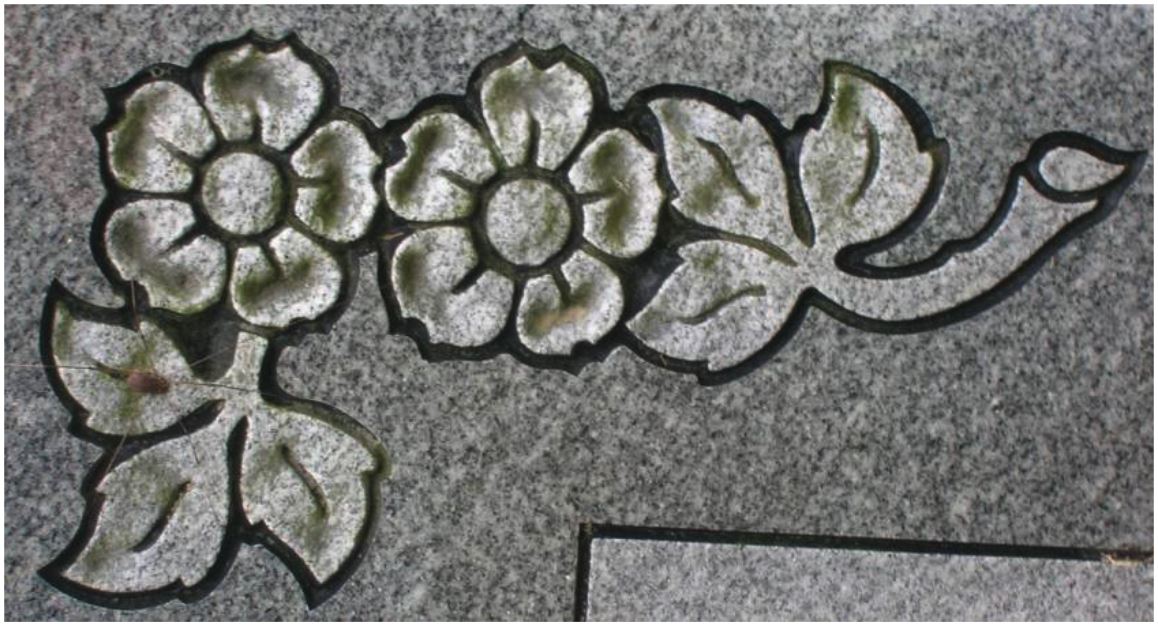
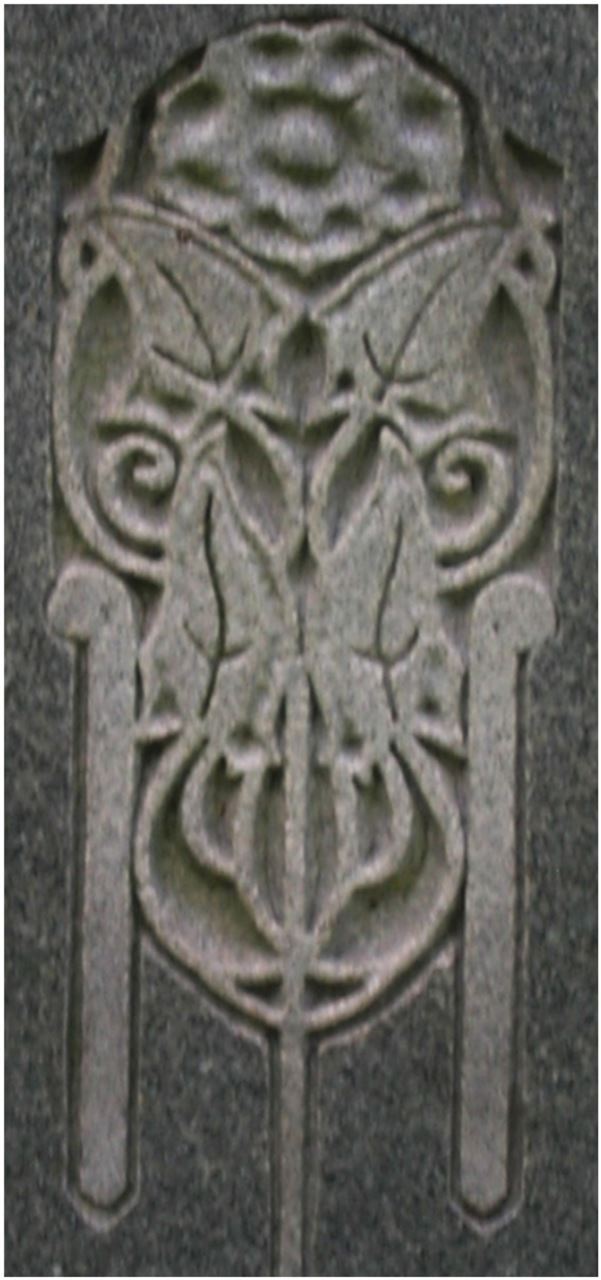
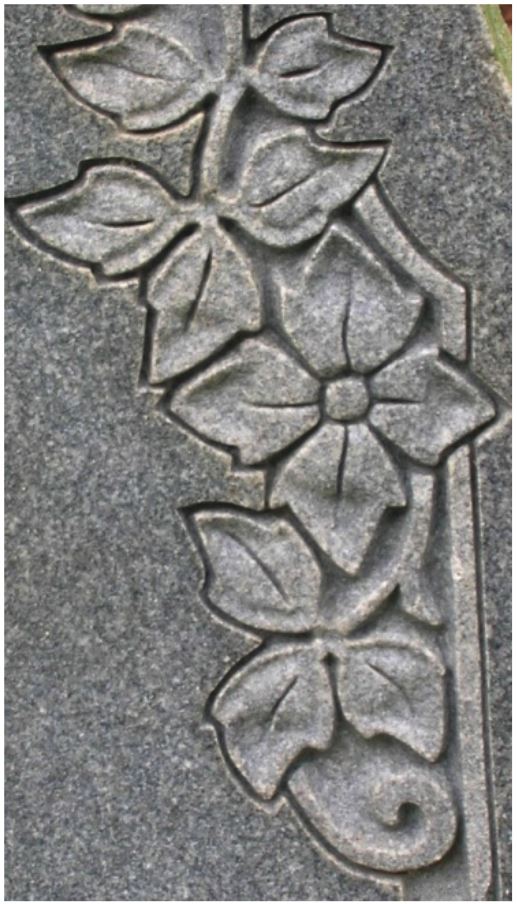
There is some unusual artwork to be found among gravestones inHillcrest, in both the older and the more contemporary markers.


And quite interesting are these two footstones. For the father, with a mortar and trowel, and the mother, with a rake and hoe.
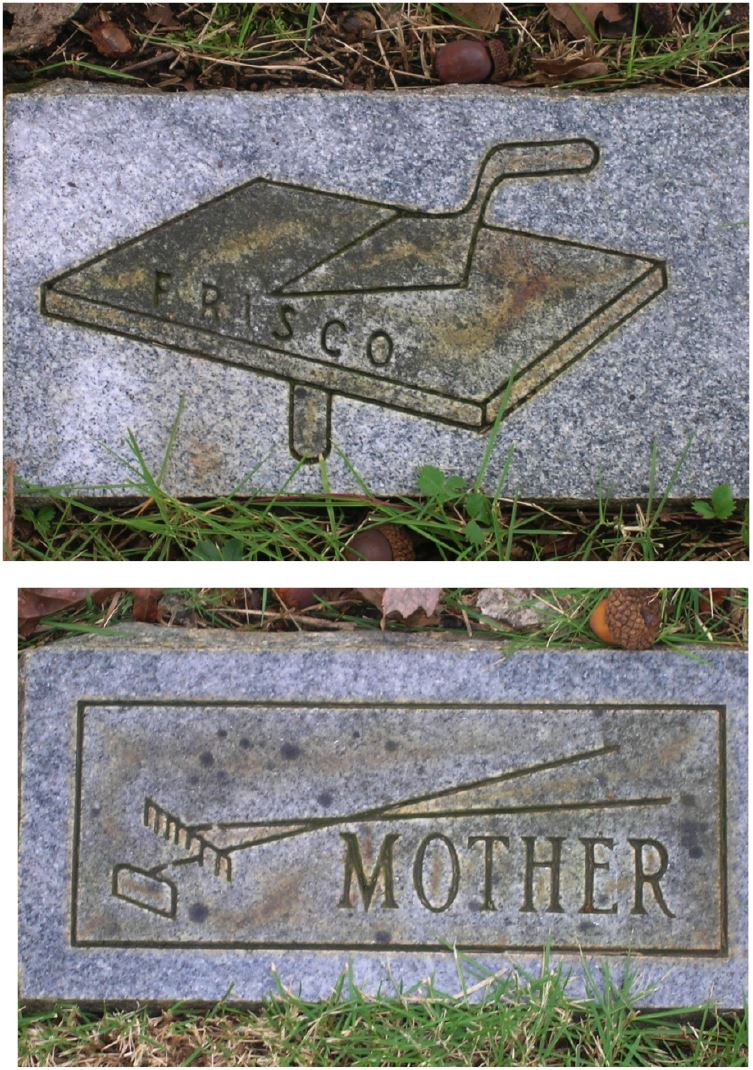
MYSTERY: What is this symbol? What does it mean?
 The bent arm on the monument of C.M. Baucom pictured to the right is taken from the emblem of the Order of Railway Conductors, Scottish Rite. The lantern (which looks more like a grenade on the monument) is easily identifiable on the emblem; the tool remains unidentified. C. M. Baucom was a Seaboard freight conductor. He also served in the Spanish American War and WWI.
The bent arm on the monument of C.M. Baucom pictured to the right is taken from the emblem of the Order of Railway Conductors, Scottish Rite. The lantern (which looks more like a grenade on the monument) is easily identifiable on the emblem; the tool remains unidentified. C. M. Baucom was a Seaboard freight conductor. He also served in the Spanish American War and WWI.
Religious Symbols are also widely used in Hillcrest. Here you see, in the upper left corner, the praying hands; beneath them, the crown, symbolizing victory, leadership and distinction, but more often in funerary, the crown represents the sovereignty of the Lord. On the right, the Latin cross shown here with a heart, likely symbolizing the love of Christ; and below it, the Star of David. In the center is the Celtic cross. The initials, IHS, in the center, are derived from the first three letters of Jesus’ name using the Greek alphabet: Iota, Eta, and Sigma.

Walking through Hillcrest, you are reminded of those who served their country in the military. From reviewing cemetery surveys, we’ve identified some 62 gravestones that speak of the role these brave men and women played in defending our country and standing for their ideals. The records reflect service in five wars, all branches of the military, and rankings at all different levels. Here are two of the more elaborate gravestones that speak of the service record of those they memorialize. The prominent flags on these monuments memorialize the service of the men buried here to their country.

Before we leave symbology, we must mention the secret societies, clubs and fraternal organizations symbolized on the grave markers at Hillcrest. The most prevalent symbol in Hillcrest is that of the Masons. More than a dozen markers carry the Masons’ symbol, the square and compass. It is said that the square and compass re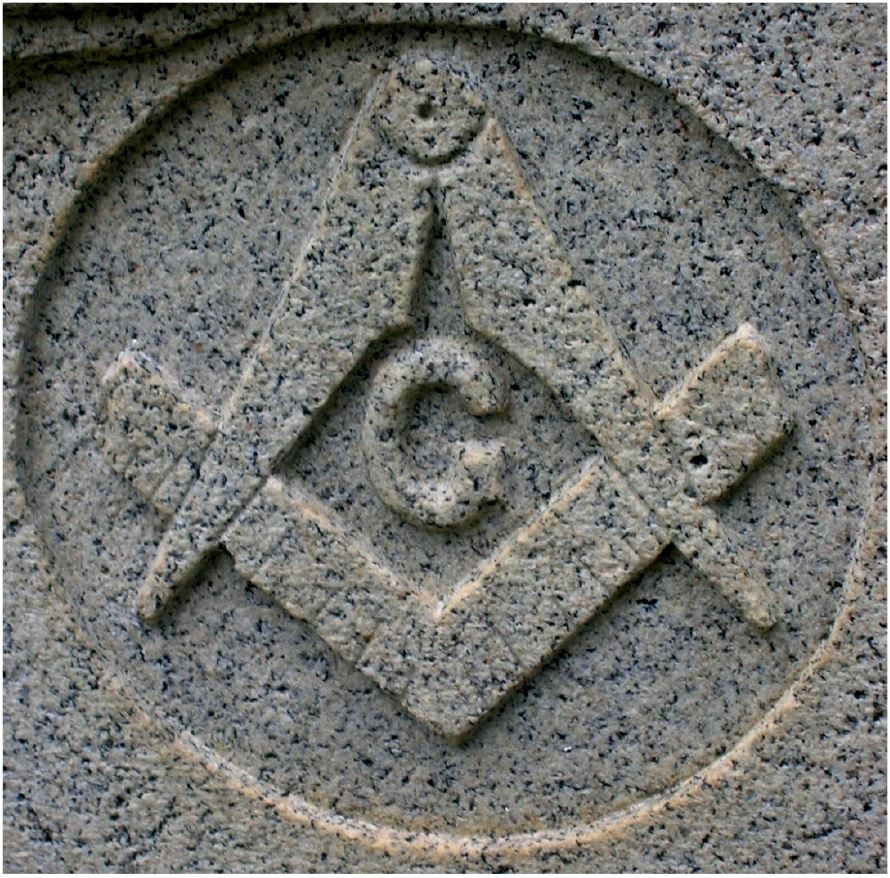 presents the interaction between mind and matter and refer to the progression from the material to the intellectual and spiritual. The letter G in the center – some say this stands for ”God” while others say it stands for “geometry.” According to the book, “Around and About Cary,” Cary Lodge No. 198 of the Ancient Free and Accepted Masons was chartered on November 17, 1857 - 14 years before the town was incorporated. A great deal of secrecy surrounds the organization – and those are secrets that we couldn’t tell you, even if we knew them.
presents the interaction between mind and matter and refer to the progression from the material to the intellectual and spiritual. The letter G in the center – some say this stands for ”God” while others say it stands for “geometry.” According to the book, “Around and About Cary,” Cary Lodge No. 198 of the Ancient Free and Accepted Masons was chartered on November 17, 1857 - 14 years before the town was incorporated. A great deal of secrecy surrounds the organization – and those are secrets that we couldn’t tell you, even if we knew them.
Other clubs, societies and organizations are also represented in Hillcrest. Here are more of the emblems we found. The emblem of the Eastern Star (far left) is frequently seen on the marker for the wife of a Mason – rightly so, since the Order of the Eastern Star is the female counterpart toFree masonry. In the center is the emblem of the American Legion, primarily an association for military veterans. The emblem of Woodmen of the World (right) is one of the best-represented in cemeteries, because until the 1920s, each member was provided with a tombstone. Other organizations represented at Hillcrest, but not pictured here, include Sons of the American Revolution, Daughters of the American Revolution, Rotary International, Shriners and Boy Scouts of America.

To tour Hillcrest is to take a stroll through Cary’s history.
 Hillcrest is the final resting place of 15 of Cary’s mayors, the earliest of these being JPH Adams, Cary’s second mayor, serving in 1871; J.P.H. Adams, Mayor in1884; and Robert J. Harrison, Cary’s mayor in 1903. But mayors aren’t the only notable citizens we found at Hillcrest. You’ll recognize many of them, because they have also been memorialized in other ways throughout our community. Here is just a sampling:
Hillcrest is the final resting place of 15 of Cary’s mayors, the earliest of these being JPH Adams, Cary’s second mayor, serving in 1871; J.P.H. Adams, Mayor in1884; and Robert J. Harrison, Cary’s mayor in 1903. But mayors aren’t the only notable citizens we found at Hillcrest. You’ll recognize many of them, because they have also been memorialized in other ways throughout our community. Here is just a sampling:
Captain Harrison P. Guess, 1827 – 1919
 Captain Guess was among the first “railroad men” to arrive in Cary. His position was recorded as “road master.” His name is familiar to many of us, because it graces the historic pink Guess-Ogle Home in downtown Cary. “Around and About Cary” tells us that the home takes its name from Captain Guess due to the fact that in 1880, he and his wife, Aurelia, purchased 16 acres of land from Frank Page, including the site of the Guess-Ogle Home.
Captain Guess was among the first “railroad men” to arrive in Cary. His position was recorded as “road master.” His name is familiar to many of us, because it graces the historic pink Guess-Ogle Home in downtown Cary. “Around and About Cary” tells us that the home takes its name from Captain Guess due to the fact that in 1880, he and his wife, Aurelia, purchased 16 acres of land from Frank Page, including the site of the Guess-Ogle Home.
Dr. J. M. Templeton 1855 – 1932
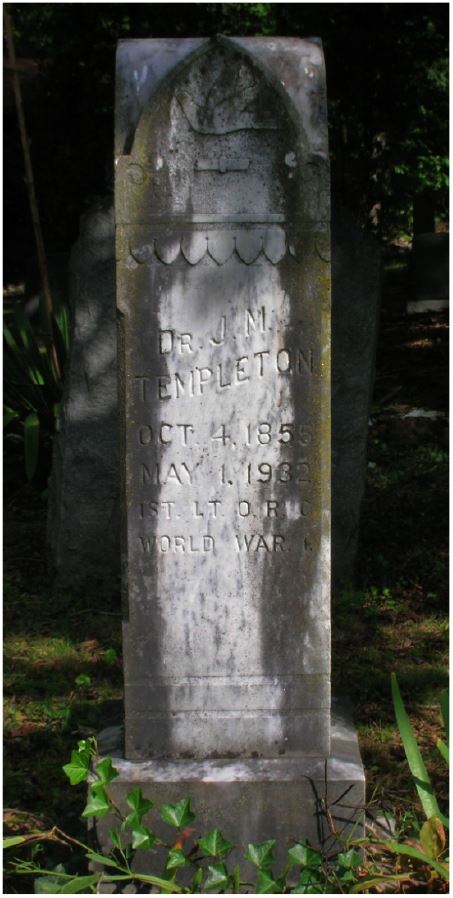 One of Cary’s earliest doctors, Dr. Templeton is described in “Around and About Cary” as a man who searched for the truth, lived by principles and practiced charity. He crusaded for Prohibition, public education, good roads and economic justice for farmers. In addition to being a doctor and surgeon, he ran a lumber business and also farmed. His gravestone carries the following inscription: A country doctor who served his nation in the time of war, his community in the time of peace, the rich and poor alike. There is a small secret here – Dr. Templeton volunteered for the Army when the United States entered World War I. But it seems he quit after 6 months, supposedly because the Army insisted that he stop wearing civilian clothes. Nevertheless, the statement is true – he DID serve his nation in the time of war. You can see Dr. Templeton’s uniform in the Cary History Museum.
One of Cary’s earliest doctors, Dr. Templeton is described in “Around and About Cary” as a man who searched for the truth, lived by principles and practiced charity. He crusaded for Prohibition, public education, good roads and economic justice for farmers. In addition to being a doctor and surgeon, he ran a lumber business and also farmed. His gravestone carries the following inscription: A country doctor who served his nation in the time of war, his community in the time of peace, the rich and poor alike. There is a small secret here – Dr. Templeton volunteered for the Army when the United States entered World War I. But it seems he quit after 6 months, supposedly because the Army insisted that he stop wearing civilian clothes. Nevertheless, the statement is true – he DID serve his nation in the time of war. You can see Dr. Templeton’s uniform in the Cary History Museum.
Marcus Baxter Dry, 1871 – 1946
 Marcus Baxter Dry was Principal of Cary High School for 34 years, from 1908 through 1942. He also served as Superintendent of the Cary School District. Under his leadership, North Carolina’s first state-supported high school, Cary High, became a model for all that followed. It is said that his success as an educator stemmed from his genuine interest in each student and his ability to embrace new ideas over the course of his career. Dry was instrumental in the construction and modernization of Cary High School’s buildings during his tenure. In 1913, under Dry’s leadership, a brick building was built on the school’s site. The current building, which now serves as the Cary Arts Center, was constructed just a few years before Dry’s retirement.
Marcus Baxter Dry was Principal of Cary High School for 34 years, from 1908 through 1942. He also served as Superintendent of the Cary School District. Under his leadership, North Carolina’s first state-supported high school, Cary High, became a model for all that followed. It is said that his success as an educator stemmed from his genuine interest in each student and his ability to embrace new ideas over the course of his career. Dry was instrumental in the construction and modernization of Cary High School’s buildings during his tenure. In 1913, under Dry’s leadership, a brick building was built on the school’s site. The current building, which now serves as the Cary Arts Center, was constructed just a few years before Dry’s retirement.
Dry’s residence was just east of the school and, today, is a contributing structure in the Cary Historic District. It is fitting, then, that both his house and the school are located on what is now called Dry Avenue.
Dr. Frank Yarborough, 1895 – 1957
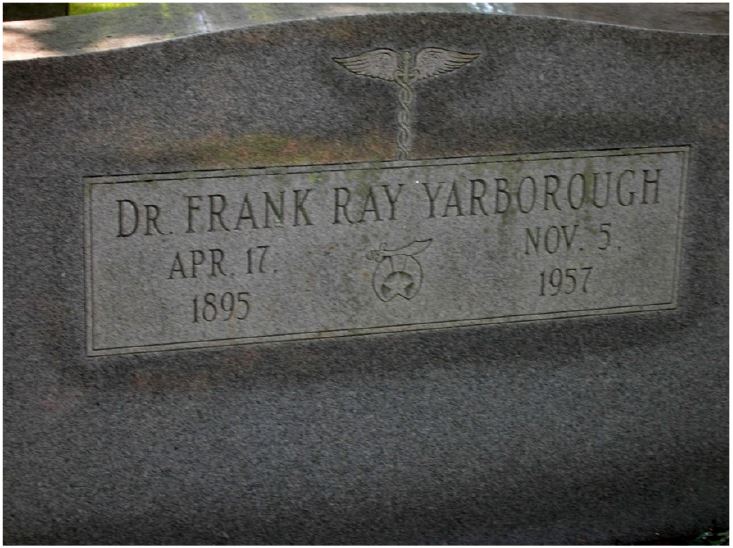 Another of Cary’s earliest doctors, Dr. Yarborough first practiced with Dr. Templeton. He also practiced at Rex Hospital when it was located on St. Mary’s Street in Raleigh. His home, where he established his own practice, stands today in the Cary Historic District, and still retains the two side entrances for his patients. One entrance was for those who were white, the other for those who were black. In Cary’s oral history book, “Just a Horse Stopping Place,” there is the following account, recalled by Dr. Yarborough’s son: “He (referring to his father, Dr. Yarborough) built the office at the present location on Park Street that was connected to our home. He practiced there for the entire time that I can remember him practicing medicine. The cars would line Park Street on both sides of the street from morning until night. And when I say night, I mean eleven, twelve o’clock. When I’d come home from school in the day, it was just a line of cars like a big procession going on. His office hours at night were Monday, Wednesday and Friday. The rest of the nights, and even when he got out of the office, he would make house calls.”
Another of Cary’s earliest doctors, Dr. Yarborough first practiced with Dr. Templeton. He also practiced at Rex Hospital when it was located on St. Mary’s Street in Raleigh. His home, where he established his own practice, stands today in the Cary Historic District, and still retains the two side entrances for his patients. One entrance was for those who were white, the other for those who were black. In Cary’s oral history book, “Just a Horse Stopping Place,” there is the following account, recalled by Dr. Yarborough’s son: “He (referring to his father, Dr. Yarborough) built the office at the present location on Park Street that was connected to our home. He practiced there for the entire time that I can remember him practicing medicine. The cars would line Park Street on both sides of the street from morning until night. And when I say night, I mean eleven, twelve o’clock. When I’d come home from school in the day, it was just a line of cars like a big procession going on. His office hours at night were Monday, Wednesday and Friday. The rest of the nights, and even when he got out of the office, he would make house calls.”
 Hillcrest Cemetery also holds many stories of tragedy and great sadness. Among these is the story of Dr. Yarborough’s daughter, Mary. Mary Ray Yarborough was said to be “the apple of her father’s eye” and family members recall that she called him “Daddy Blue Eyes.” When she was 11 years old, she contracted meningitis, and, unfortunately, the medical treatment she received was unable to save her. It was said that the anguish of her death tore the Yarborough’s marriage apart. Their love for her is there at Hillcrest for all of us to see, in the bust of Mary that marks her grave in the family plot.
Hillcrest Cemetery also holds many stories of tragedy and great sadness. Among these is the story of Dr. Yarborough’s daughter, Mary. Mary Ray Yarborough was said to be “the apple of her father’s eye” and family members recall that she called him “Daddy Blue Eyes.” When she was 11 years old, she contracted meningitis, and, unfortunately, the medical treatment she received was unable to save her. It was said that the anguish of her death tore the Yarborough’s marriage apart. Their love for her is there at Hillcrest for all of us to see, in the bust of Mary that marks her grave in the family plot.
R. S. “Dad” Dunham, 1905 – 1987
 This well-known teacher at Cary High School owned a 30-acre tract of land on Kildaire Farm Road, which was described as “the closest thing Cary had to a botanical garden.” Mr. Dunham’s agriculture students at Cary High received much of their forestry training on these grounds, which later became the site of the Glenaire, among the earliest of Cary’s continuing care retirement communities. It was the Dunhams desire to see their land used for this purpose. If “Dad” Dunham’s name looks familiar to you, it may be that you’ve visited the popular neighborhood park on Walnut Street that was named after him.
This well-known teacher at Cary High School owned a 30-acre tract of land on Kildaire Farm Road, which was described as “the closest thing Cary had to a botanical garden.” Mr. Dunham’s agriculture students at Cary High received much of their forestry training on these grounds, which later became the site of the Glenaire, among the earliest of Cary’s continuing care retirement communities. It was the Dunhams desire to see their land used for this purpose. If “Dad” Dunham’s name looks familiar to you, it may be that you’ve visited the popular neighborhood park on Walnut Street that was named after him.
Tammy Lynn Pierce, 1957 – 1971
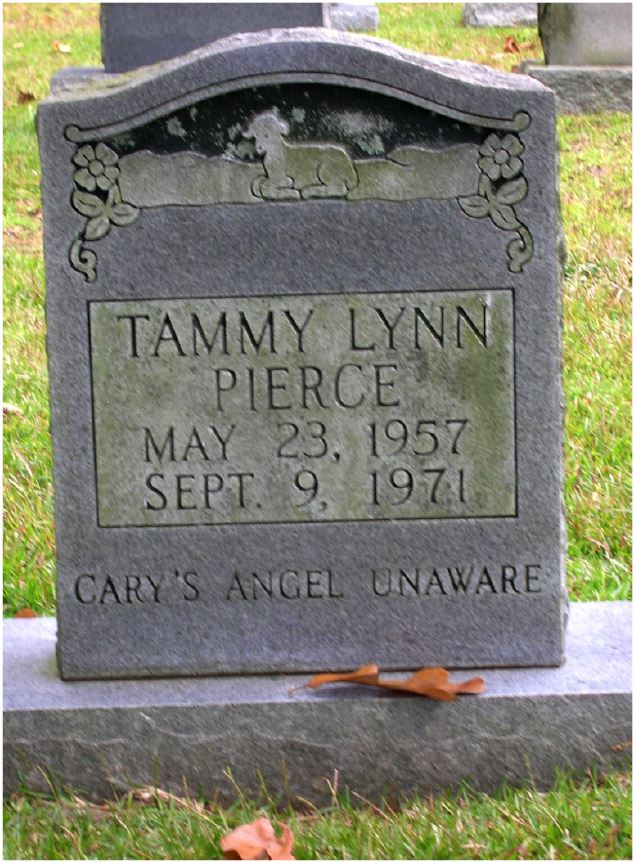 Described on her gravestone as, “Cary’s Angel Unaware,” Tammy Lynn Pierce sustained a brain injury at birth and lived all of her 14 years in the family’s home on Kildaire Farm Road. At that time there were no custodial homes in North Carolina for children with developmental disabilities, and her family refused to place her in a state institution. Prior to her death, Tammy Lynn’s parents joined two Raleigh couples in similar circumstances to create a foundation that would lead to the establishment of the Tammy Lynn Center for Development Disabilities. Today, the Tammy Lynn Center offers education, residential, and family support services to children and adults with special needs. The Center's goal is to provide the individuals it serves the opportunity to maximize their abilities in a loving, nurturing environment.
Described on her gravestone as, “Cary’s Angel Unaware,” Tammy Lynn Pierce sustained a brain injury at birth and lived all of her 14 years in the family’s home on Kildaire Farm Road. At that time there were no custodial homes in North Carolina for children with developmental disabilities, and her family refused to place her in a state institution. Prior to her death, Tammy Lynn’s parents joined two Raleigh couples in similar circumstances to create a foundation that would lead to the establishment of the Tammy Lynn Center for Development Disabilities. Today, the Tammy Lynn Center offers education, residential, and family support services to children and adults with special needs. The Center's goal is to provide the individuals it serves the opportunity to maximize their abilities in a loving, nurturing environment.
Fascinating Inscriptions
We couldn’t leave Hillcrest without sharing with you some of the fascinating inscriptions found on the grave markers. And, yes, there are a few mysteries and secrets waiting for us here.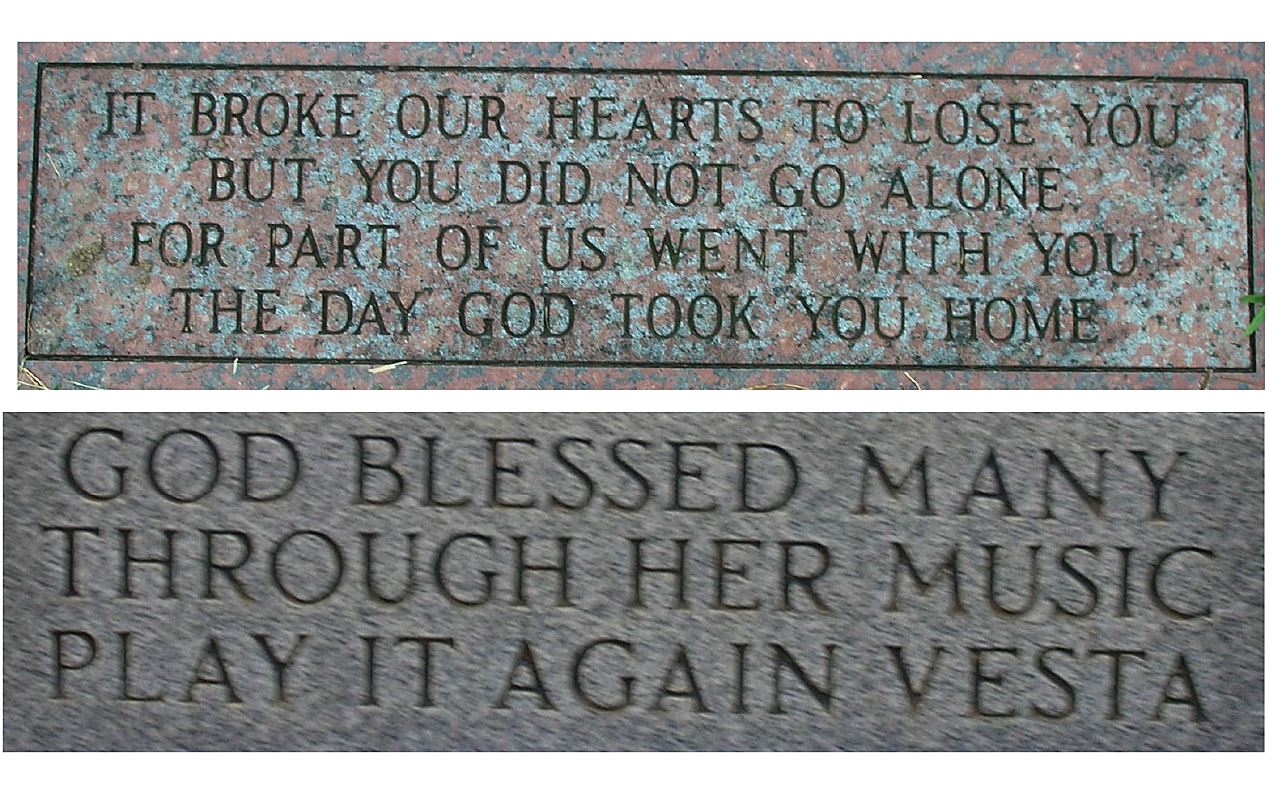 Inscriptions provide the opportunity for those who are deceased to continue to speak to us. Or, in some cases, the message is from loved ones, telling us about the one who has passed away. Some inscriptions give us advice and others recite Bible scriptures that tell us of the person’s religious devotion. The book, “Sticks and Stones: Three Centuries of North Carolina Gravemarkers,“ tells us that an influx of British stonecutters arrived here in the 1830s to work on the new state capitol in Raleigh and other major masonry projects. In 1837, North Carolina’s first resident funerary monument firm was established in Raleigh. Once rail lines were complete, more commercial stonecutters set up marble yards along the rails. While the railroad caused the proliferation of small marble yards, it also led to their demise. In the early 1900s, small marble yards were absorbed by larger ones and the ease of shipping monuments by rail led to the rise of the mail-order monument business. New stonecutting technology allowed for the use of granite, instead of marble, and within a few years, the artistic role of the stonecutter changed from sculptor of the overall monument to mere engraver of the inscription. Today, stonecutters still work in North Carolina, but most of their business is sandblasting inscriptions onto blanks. With only a few exceptions, gravestone carving is a lost art.
Inscriptions provide the opportunity for those who are deceased to continue to speak to us. Or, in some cases, the message is from loved ones, telling us about the one who has passed away. Some inscriptions give us advice and others recite Bible scriptures that tell us of the person’s religious devotion. The book, “Sticks and Stones: Three Centuries of North Carolina Gravemarkers,“ tells us that an influx of British stonecutters arrived here in the 1830s to work on the new state capitol in Raleigh and other major masonry projects. In 1837, North Carolina’s first resident funerary monument firm was established in Raleigh. Once rail lines were complete, more commercial stonecutters set up marble yards along the rails. While the railroad caused the proliferation of small marble yards, it also led to their demise. In the early 1900s, small marble yards were absorbed by larger ones and the ease of shipping monuments by rail led to the rise of the mail-order monument business. New stonecutting technology allowed for the use of granite, instead of marble, and within a few years, the artistic role of the stonecutter changed from sculptor of the overall monument to mere engraver of the inscription. Today, stonecutters still work in North Carolina, but most of their business is sandblasting inscriptions onto blanks. With only a few exceptions, gravestone carving is a lost art.
We identified interesting and intriguing inscriptions at Hillcrest. Some are serious, while others add a touch of humor. Here is a sampling of those we found and liked:
- Love makes memory eternal
- She hath done what she could
- Redeeming love has been my theme . . .
- To live in the hearts we leave behind is not to die
- Always Giving Never Asking
- Your legacy of love and laughter lives on through your family
- She was too good, too gentle and fair to dwell in this cold world
- Under The Dew, The Sun And The Stars, I Wait For You
We were also touched by the simplicity of this hand-engraved marker.
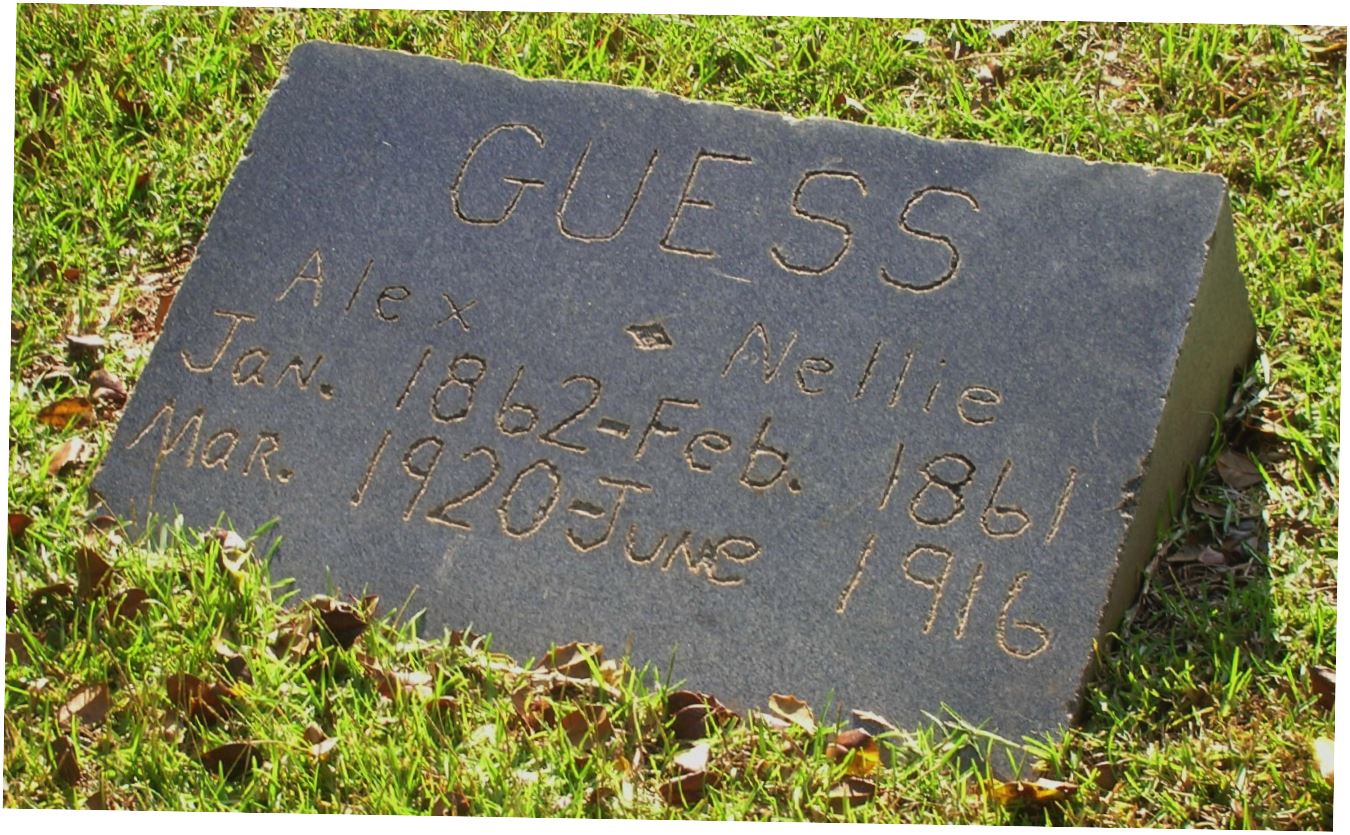
One of the most loved inscriptions – and the one that made us really smile – was found on the back of the gravestone of Shirley Faye Tharpe.

Lasting Farewell
It is time to leave Hillcrest, with our invitation to you to visit this beautiful, peaceful and intriguing Cary treasure on your own. We think you’ll fall in love with it, as we have. As we depart Hillcrest, we’ll also leave you with this sage advice from one who is buried there.
Remember friends as you pass by
As you are now so once was I
As I am now, so you must be
Prepare therefore to follow me.
Join Us on a Live Tour of Hillcrest Cemetery
We're going to take you to the White Plains Cemetery via live streaming on our
Facebook page later this month. And because it's October and we're visiting a cemetery, there might be a few spooky surprises. Follow us on Facebook to learn more.
